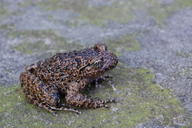|
Oreolalax major (Liu & Hu, 1960)
Large Toothed Toad | family: Megophryidae subfamily: Leptobrachiinae genus: Oreolalax |
 © 2008 LI Cheng (1 of 2)
|
|
|
|
Description The male is 68 mm and the female is 70 mm in body length. This species has vertical pupils. The tympanum is hidden. Maxillary teeth are developed. The dorsum is covered with spiny tubercles of varying sizes with black spines. The back legs are relatively large, with the tibiotarsal articulation extending to the eye. Digit tips are rounded. There is a relatively wide fringe on the sides of the toes, and the fourth toe is 1/3 webbed. The dorsum is olive green with striking black spots. No triangular mark is present on the interorbital space. Wide bands are present on the limbs. The ventrum has dark palm piebald markings, and the markings on the throat and ventral surface of limbs are even more obvious. The male has thin and dense nuptial spines on the first and second fingers. The dorsal surface of the forelimbs, the sides of the body, and the lower belly all have spiny clusters. The chest has a pair of extremely large, spiny clusters. Tadpoles are 65 mm in body length and 23 mm in head length. The tail is palm brown, with thin black dots, and the caudal fin is light in color. The caudal fin extends up to the base of the tail. The labial tooth row formula is I: 4-4/I: 4-4 and a few cases I: 5-5/I: 5-5. Two papillae are lacking from the center of the upper lip (Fei 1999). Distribution and Habitat Country distribution from AmphibiaWeb's database: China
Life History, Abundance, Activity, and Special Behaviors Trends and Threats Possible reasons for amphibian decline General habitat alteration and loss
References
Fei, L. (1999). Atlas of Amphibians of China. Henan Publishing House of Science and Technology, Zhengzhou. IUCN, Conservation International, and NatureServe. 2006. Global Amphibian Assessment. www.globalamphibians.org. Accessed on 06 July 2007. Originally submitted by: Sijie Mao (first posted 2007-05-18) Edited by: Kellie Whittaker (2007-07-06) Species Account Citation: AmphibiaWeb 2007 Oreolalax major: Large Toothed Toad <https://amphibiaweb.org/species/5305> University of California, Berkeley, CA, USA. Accessed Nov 12, 2024.
Feedback or comments about this page.
Citation: AmphibiaWeb. 2024. <https://amphibiaweb.org> University of California, Berkeley, CA, USA. Accessed 12 Nov 2024. AmphibiaWeb's policy on data use. |



 Map of Life
Map of Life